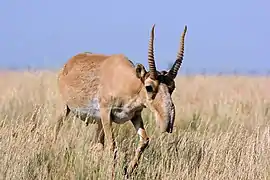| Saigini | |
|---|---|
 | |
| Saiga tatarica male | |
| Scientific classification | |
| Domain: | Eukaryota |
| Kingdom: | Animalia |
| Phylum: | Chordata |
| Class: | Mammalia |
| Order: | Artiodactyla |
| Family: | Bovidae |
| Subfamily: | Antilopinae |
| Tribe: | Saigini Simpson, 1945 |
| Genera | |
|
see text | |
Saigini is a tribe of artiodactyl mammals of the Bovidae family, subfamily Antilopinae, comprising two species of medium-sized antelopes that inhabit the Eurasian steppes.
Taxonomy
Description
The tribe was created in 1945 by the American paleontologist and theoretical biologist George Gaylord Simpson.[1] According to the Simpson classification the tribe comprises two monospecific genera:
- Tribus Saigini
- Genus Pantholops
- Genus Saiga
A controversial taxonomy
Saiga and Pantholops are problematic genera in taxonomy.[2] Saiga was traditionally classified as a member of the tribe Saigini, within the subfamily Caprinae[1][3] but some authors suggested that the genus Saiga was closer to the subfamily Antilopinae. [4] In 2000 Groves analyzed the morphological characters of Procapra, Prodorcas and Saiga, and proposed three basal groups of Antilopinae, one of which included a clade Saiga + Procapra.[5]
The genus Panthalops is monotypic (P. hodgsonii), and is sometimes included in the tribe Saigini on the basis of similar morphological features, most of which are plesiomorphic. However, molecular and morphological findings suggest that Pantholops hodgsonii should be classified more correctly in the subfamily Caprinae,[4][6] but the status of the Tibetan gazelle in this subfamily remains uncertain. Data on cytochrome b and small portions of 12S and 16S ribosomal genes suggest phylogenetic affinities of Saiga and Procapra with Antilopinae.[4][7][8] However, these studies do not clarify the close relationships within this clade. Given this uncertainty, some authors have suggested that the Saigini taxon should be abandoned.[8]
References
- 1 2 Simpson, G. G. (1945). "The principles of classification and a classification of mammals". Bull. Am. Mus. Nat. Hist. 85: 1–350.
- ↑ Kuznetsova, Maria V.; Kholodova, Marina V. (December 2002). "Molecular support for the placement of Saiga and Procapra in Antilopinae (Artiodactyla, Bovidae)". Mammalian Evolution. 9 (4): 271–280. doi:10.1023/A:1023973929597. S2CID 27452274.
- ↑ Bannikov, A.; L. Zhirnov; Lebedeva & Fadeev, A (1967): "Biology of the Saiga". Israel Program for Scientifica Translatios, Jerusalem.
- 1 2 3 Gentry, A.W. (March 1992). "The subfamilies and tribes of the family Bovidae". Mammal Review. 22 (1): 1–32. doi:10.1111/j.1365-2907.1992.tb00116.x.
- ↑ Groves, C. P. (2000). "Phylogenetic relationships within recent Antlopini (Bovidae). In: Elizabeth S. Vrba and George B. Schaller, eds. Antelopes, Deer, and Relatives: Fossil Record, Behavioral Ecology, Systematics, and Conservation. New Haven and London: Yale University Press. ISBN 978-0-3000-8142-8, pp. 223-233.
- ↑ Gatesy, John; Amato, George; Vrba, Elizabeth; Schaller, George; DeSalle, Rob (June 1997). "A cladistic analysis of mitochondrial ribosomal DNA from the Bovidae". Molecular Phylogenetics and Evolution. 7 (3): 303–319. doi:10.1006/mpev.1997.0402. PMID 9187090.
- ↑ Hassanin, Alexandre; Douzery, Emanuel J.P. (November 1999). "The tribal radiation of the family Bovidae (Artiodactyla) and the evolution of the mitochondrial cytochrome b gene". Molecular Phylogenetics and Evolution. 13 (2): 227–243. doi:10.1006/mpev.1999.0619. PMID 10603253.
- 1 2 Hassanin, Alexandre; Douzery, Emanuel J.P. (May 1999). "Evolutionary affinities of the enigmatic saola (Pseudoryx nghetinhensis) in the context of the molecular phylogeny of Bovidae". Proceedings of the Royal Society B. 266 (1422): 893–900. doi:10.1098/rspb.1999.0720. PMC 1689916. PMID 10380679.